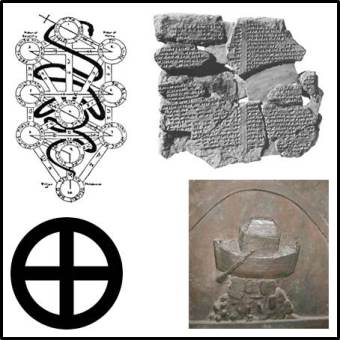THE TAKE AWAY
The Inspiration for the Noah Movie
By Kersley Fitzgerald


Single Page/Printer Friendly
Continued from Page One

When I heard the Watchers were represented as rock monsters, however, it brought to mind the golem from Jewish folklore. A golem is a crudely-formed figure, usually made of stone and clay, that is brought to life and controlled by powerful rabbis. Adam was said to be a golem before God gave him the breath of life. Mattson says that the "Watchers" seemed to be shaped like Hebrew letters. This would also reflect their status as golems, since, as Wikipedia explains, golems "could be activated by…the ritualistic use of various letters of the Hebrew Alphabet forming a 'shem' (any one of the Names of God). The shem was written on a piece of paper and inserted either in the mouth or in the forehead of the golem, thus bringing it into life and action." Another tie to Kabbalah as it teaches words and letters have great power.
There are legends of rabbis forming and animating golems. Judah Loew ben Bazalel was said to have made a golem that protected the Jewish ghetto in Prague from anti-Semitic attacks in the 16th century. It's even said a Nazi later found the golem, made inactive by removing the word from its mouth, and tried to stab it, but was killed instead. Golems have a mixed-reputation, however, protecting some while violently killing others — again similar to the Watchers of the movie.
In his review, S. Michael Houdmann points out that legend says King Og rode out the Flood on the Ark. The Hebrew Midrash says he had a special compartment in the Ark and lived until Moses killed him (Numbers 21:31-35). Deuteronomy lists Og as the last of the Rephaim or giants. If he was a descendent of the demons who took human women, it doesn't necessarily follow that he lived pre-Flood, however, since Genesis 6:4 explains the giants reappeared "after" as well.
Kabbalah also has ties to environmentalism and man's responsibility for the environment, which diverges from Gnosticism; Gnosticism sees all physical as hinderances to true enlightenment.
Perhaps the strongest tie between the Noah movie and Kabbalah has to do with Flood symbolism. In Kabbalah, the Flood represents an enlightened man (Noah) seeking guidance from and obeying a divine presence to reject the things of the world and allow possessions and all material things to be washed away. As the waters physically purified sin from the earth, the harsh experience spiritually purified Noah's heart. The apex of abandoning the material, seeking God, and understanding the light of Sophia is love — the force that stayed movie-Noah's hand from killing his granddaughters. As Song of Solomon 8:7 says, "Many waters would not be able to quench love…" With that in mind, Noah's character arc makes sense. Gnosticism says the physical must be destroyed — which he intends by killing his granddaughters. But the Flood washes away all concern for the physical until only love remains.
* One more thought brought up by my friend Kacy Barnett-Gramckow. There has been a lot of talk about how people in the movie don't use the word "God." Instead they say "Creator." What these critics don't realize is that this is entirely consistent with Judaism. Obviously, Noah wasn't Jewish, but it's not outside the realm of possibility that he would have respected the name of God in a similar fashion. It's also consistent with the fact that the movie is so influenced by a Jewish sect — Kabbalah. The use of "Creator" instead of "God" is a cultural sign of respect.
Noah and the Epic of Gilgamesh
The movie also appears to borrow some plot points from the Epic of Gilgamesh.* First off, Gilgamesh fights and kills two rock giants — foolishly, as it turns out, since they're the only ones who can take him where he wants to go — to Utnapishtim (Noah) to learn the secret of immortality. Gilgamesh builds a raft, instead, and finds Utnapishtim and his wife living alone across a great sea. Utnapishtim tells Gilgamesh his story.
The gods Anu, Enlil, Ninurta, Ennugi, and Ea intended to flood the world and kill all people, but Ea decided to rescue Utnapishtim and his wife, along with their family and friends and the animals. After the flood, Ea settled Utnapishtim and his wife in a far off place and granted them immortality. So, from the Epic of Gilgamesh, you get stone giants, Noah living apart from other people, and the gods' (unsuccessful) plan to kill every human.
The Inspiration for Noah
What does it all mean? Only this: the movie Noah was loosely based on the Genesis Flood, but it was also influenced by other sources including Jewish folklore and mysticism, Gnosticism, and the Epic of Gilgamesh. Why wasn't Aronofsky more forthcoming about this? Mattson says it's because he wanted to deceive Christians. I have a slightly different take.
Maybe he just wanted to make a movie.Does that justify the discrepancies between the movie and the Flood account in the Bible? Well, no. But consider this: it is a movie made by an atheist who used material from several different sources — some pagan. Why would you expect biblical truth as a result?
Aronofsky is an atheist. He no more believes in the Bible than he does the Kabbalah Zohar, Platonic Gnosticism, or the Epic of Gilgamesh. He just took flood myths from several different traditions and combined them into one story.
That makes about as much sense as walking out of the light and cursing because you can't see.
* Yeah, I know, I haven't seen The Passion of the Christ, but I've read the Epic of Gilgamesh.
Images; clockwise from top right: Kabbalah Tree of Life with serpent; Epic of Gilgamesh tablets, Noah's Ark from the Cathedral of Speyer, Gnostic symbol.
Tags: Biblical-Truth | Controversial-Issues | Current-Issues | Reviews-Critiques
comments powered by Disqus
Published 3-31-2014

